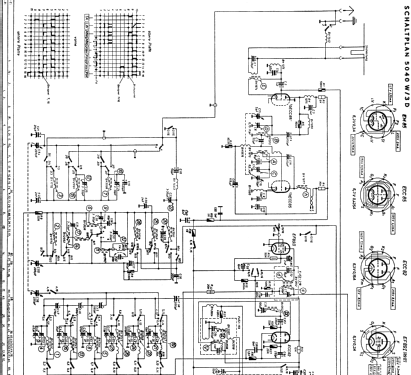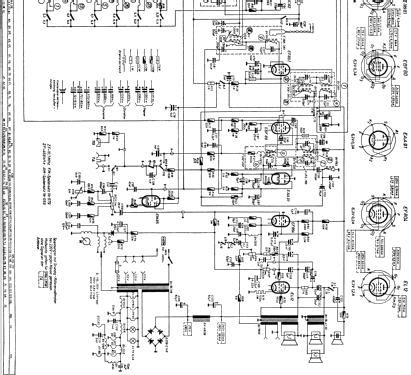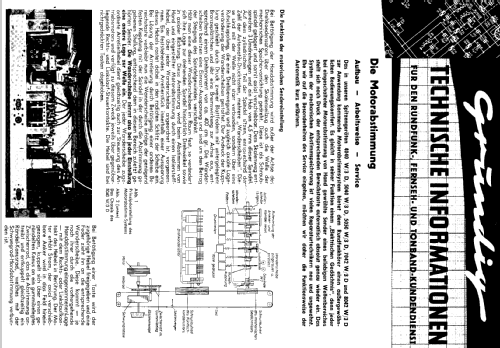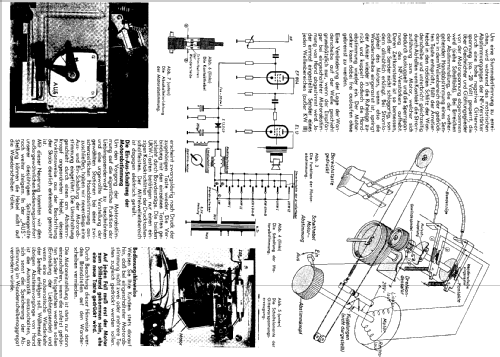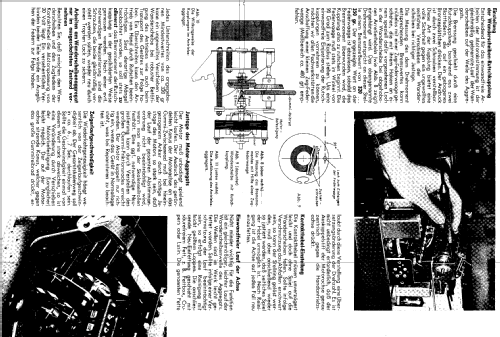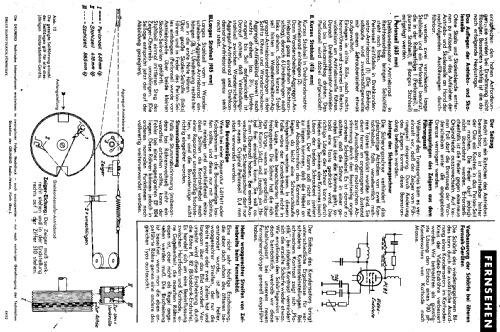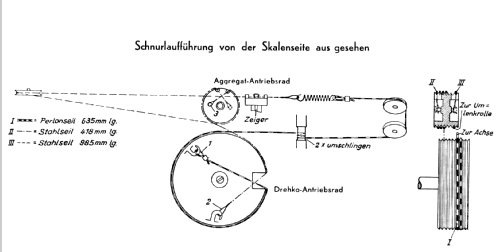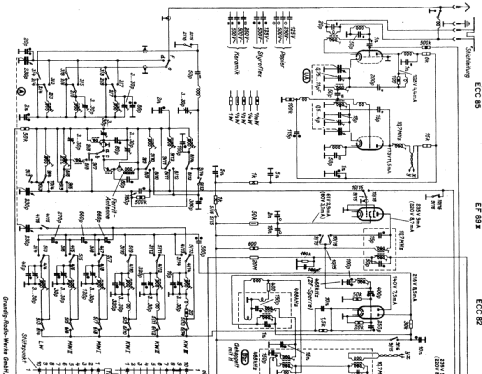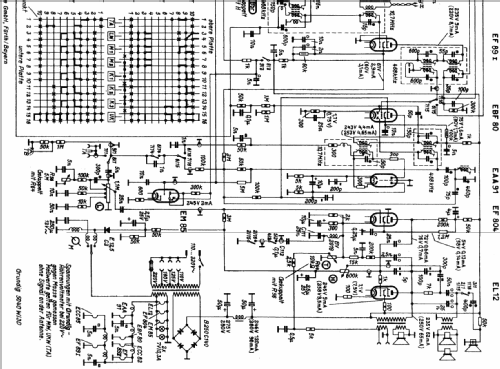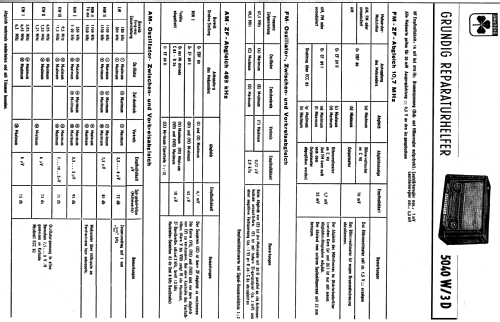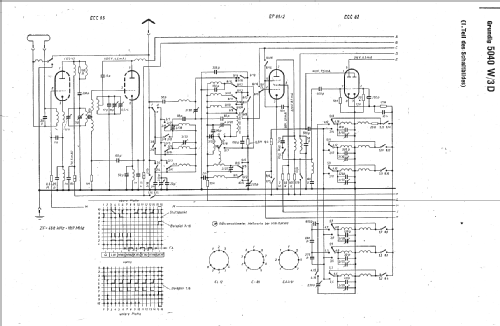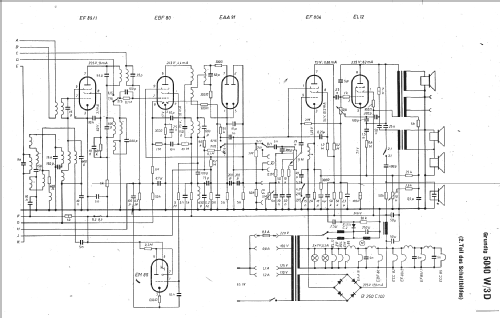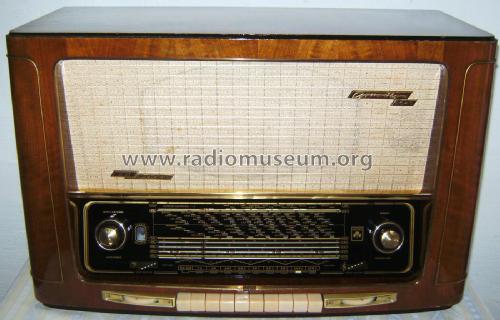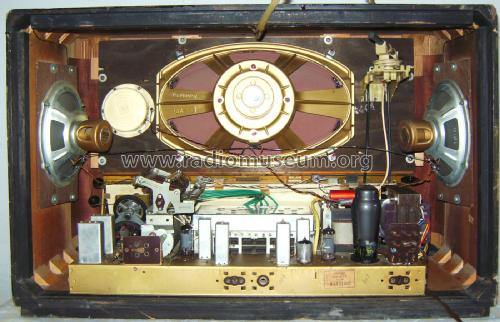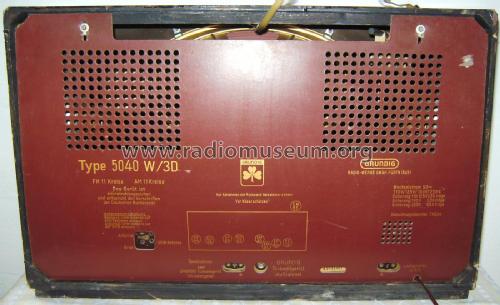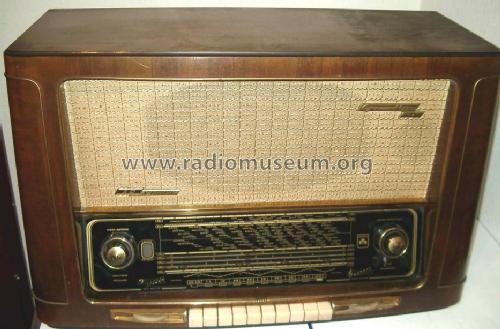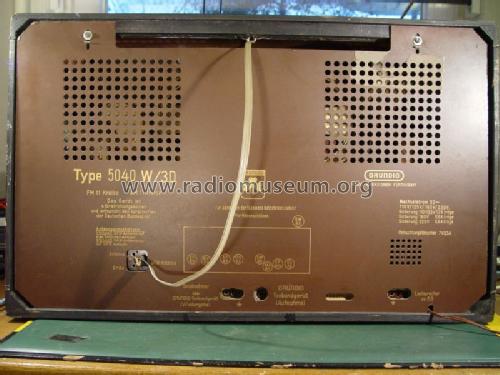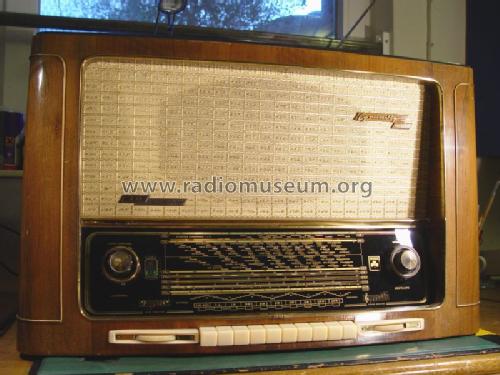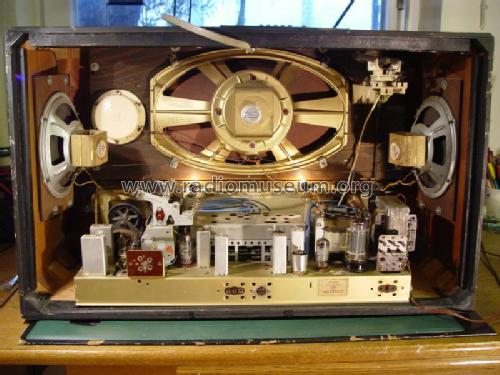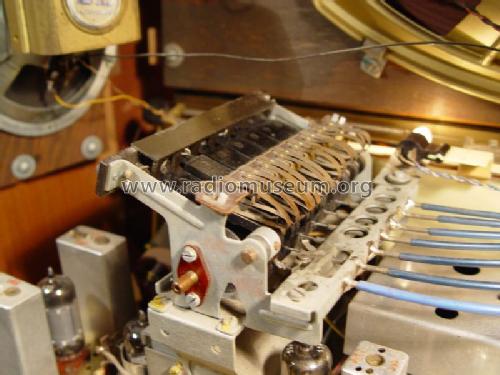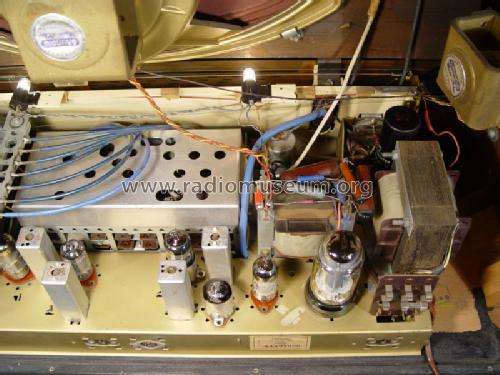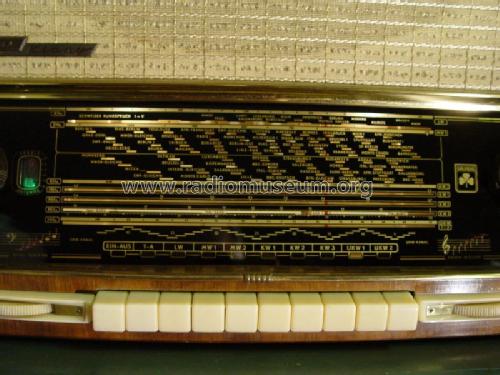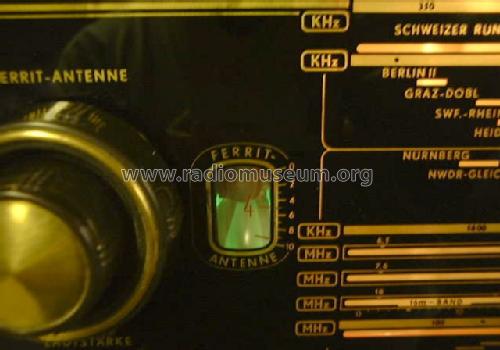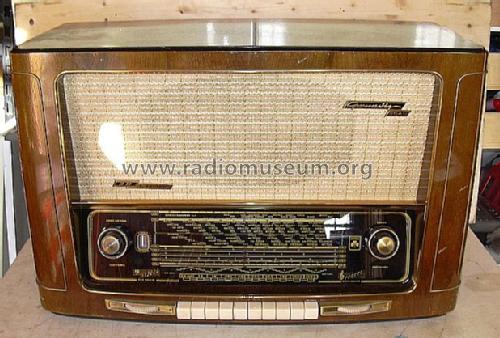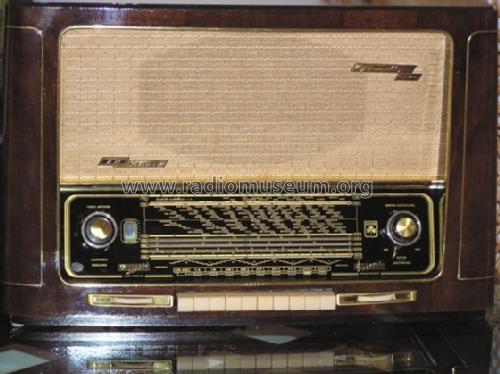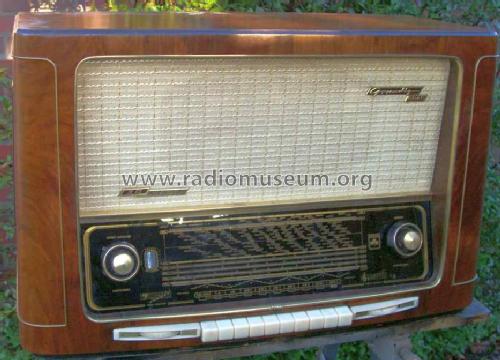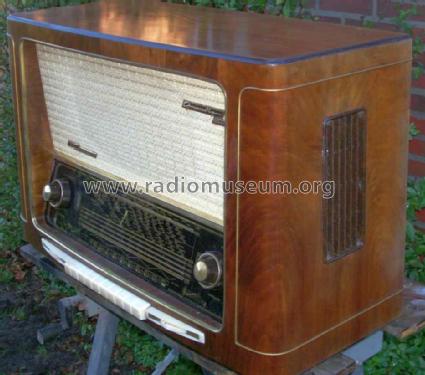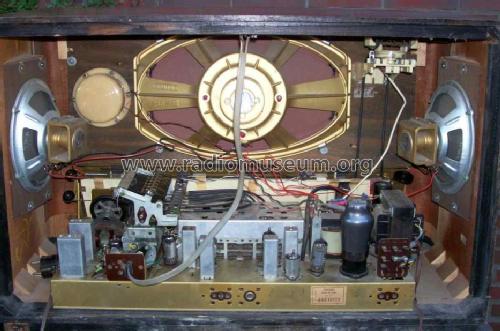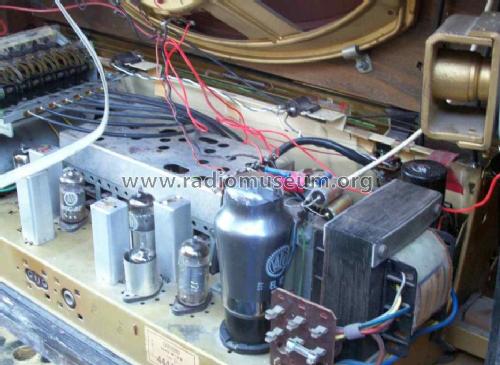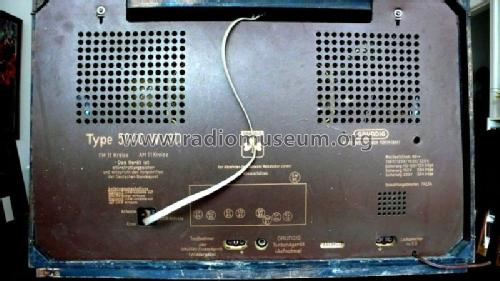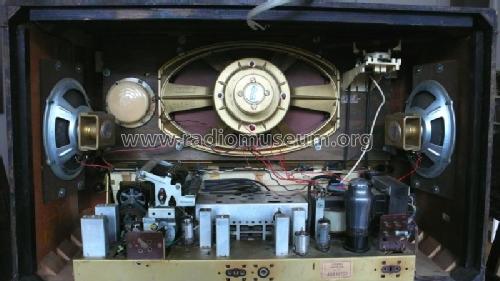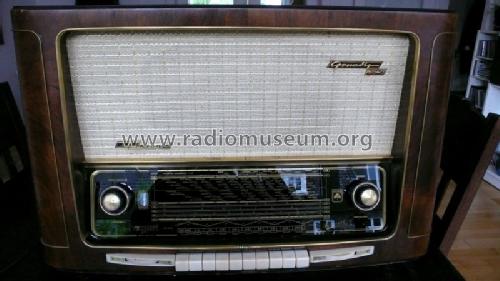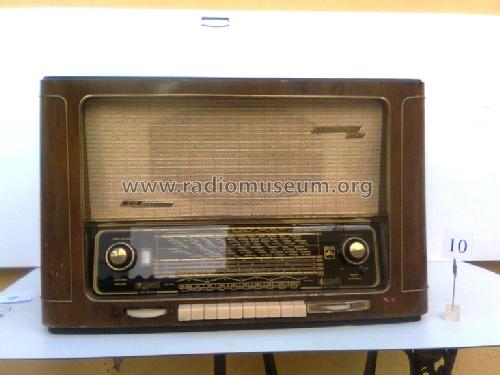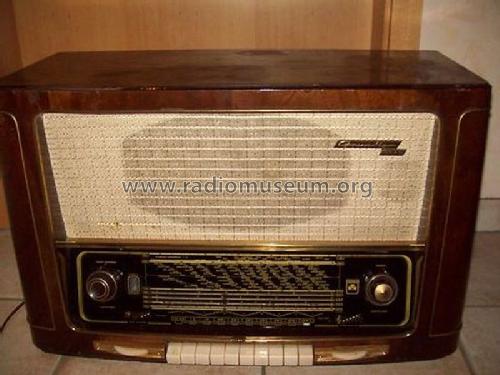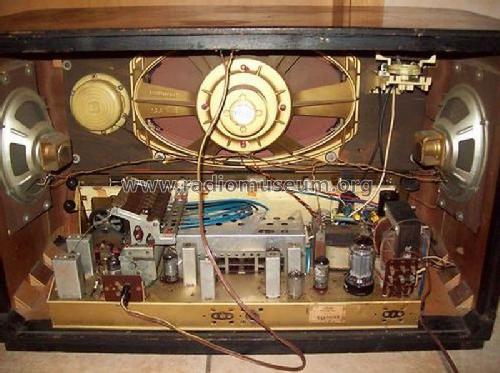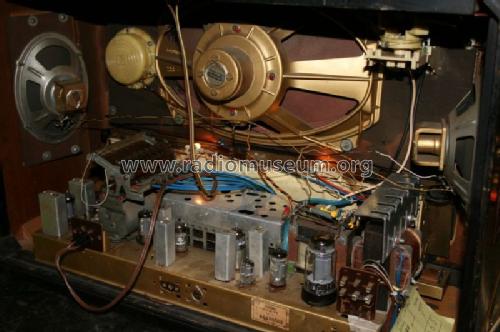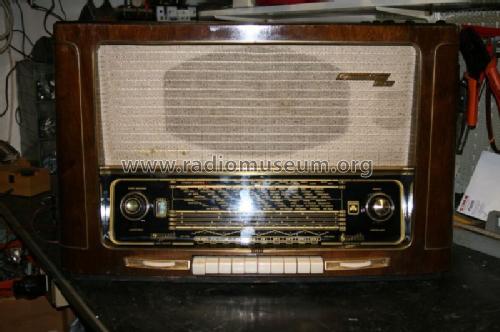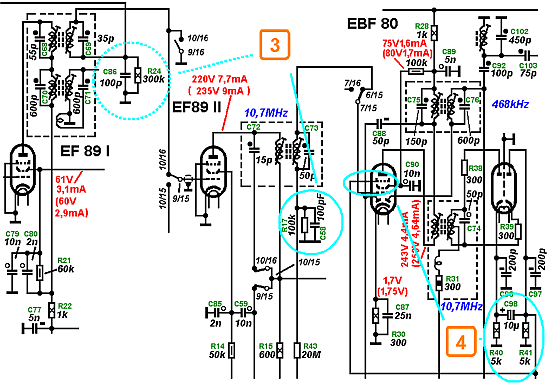- País
- Alemania
- Fabricante / Marca
- Grundig (Radio-Vertrieb, RVF, Radiowerke); Fürth/Bayern
- Año
- 1954–1956
- Categoría
- Radio - o Sintonizador pasado WW2
- Radiomuseum.org ID
- 20139
-
- alternative name: Grundig Portugal || Grundig USA / Lextronix
Haga clic en la miniatura esquemática para solicitarlo como documento gratuito.
- Numero de valvulas
- 9
- Numero de transistores
- Principio principal
- Superheterodino con paso previo de RF; ZF/IF 468/10700 kHz
- Número de circuitos sintonía
- 11 Circuíto(s) AM 11 Circuíto(s) FM
- Gama de ondas
- OM, OL, más de dos OC y FM
- Tensión de funcionamiento
- Red: Corriente alterna (CA, Inglés = AC) / 110; 125; 160; 220 Volt
- Altavoz
- 4 Altavoces
- Potencia de salida
- 8 W (unknown quality)
- Material
- Madera
- de Radiomuseum.org
- Modelo: 5040W/3D - Grundig Radio-Vertrieb, RVF,
- Forma
- Sobremesa de botonera.
- Ancho, altura, profundidad
- 706 x 444 x 318 mm / 27.8 x 17.5 x 12.5 inch
- Anotaciones
- Grundig Konzertgerät 5040W/3D.
AM/FM-Abstimmung mit Doppelknopf, Motorabstimmung auf 7 Tasten: 1x LW, 2x MW, 2x KW, 2x UKW-Sender.
Im Handbuch des Rundfunk- und Fernseh-Großhandels 1955/56 wird als Funktionsmerkmal irrtümlich automatischer Sendersuchlauf mit Scharfabstimmung angegeben. Es handelt sich um eine elektromechanische Senderspeicherung mit Motorabstimmung der vorgewählten Stationen, im Gegensatz zu den Saba-Modellen mit Motorelektronik gab es bei den Grundig-Modellen mit Abstimmmotor keinen automatischen Sendersuchlauf und keine Scharfabstimmung.
Note: For the Grundig-Majestic version of this model see Majestic 5040W/3D.
The only difference known so far is the different back cover and the Grundig-Majestic logo in the right upper corner of the speaker front. Please make sure you upload your info and pictures to the correct model.
- Peso neto
- 20.5 kg / 45 lb 2.5 oz (45.154 lb)
- Precio durante el primer año
- 565.00 DM
- Ext. procedencia de los datos
- Erb
- Procedencia de los datos
- HdB d.Rdf-& Ferns-GrH 1954/55
- Mencionado en
- HdB d.Rdf-& Ferns-GrH 1955/56
- Documentación / Esquemas (1)
- -- Schematic (D.E. Ravalico, Il Radiolibro, 16° edizione, 1957, Hoepli)
- Documentación / Esquemas (2)
- Funk-Technik (FT) (19/1954, S. 522, 523 / Die Motor-Senderwahl-Automatik)
- Documentación / Esquemas (3)
- Lange, Schaltungen der Funkindustrie (Band IV S.204f.)
- Otros modelos
-
Donde encontrará 6251 modelos, 5496 con imágenes y 4255 con esquemas.
Ir al listado general de Grundig (Radio-Vertrieb, RVF, Radiowerke); Fürth/Bayern
Colecciones
El modelo es parte de las colecciones de los siguientes miembros.
Literatura
El modelo está documentado en la siguiente literatura.
Contribuciones en el Foro acerca de este modelo: Grundig Radio-: 5040W/3D
Hilos: 32 | Mensajes: 315
Hallo zusammen,
hat jemand die Bauvorschrift für den Netztrafo des Grundig 5040W/3D
BV 96/37.
Wäre für euere Hilfe sehr dankbar.
Freundliche Grüße
Peter Breu
Peter Breu, 01.Sep.20
Grundig's 2 page alignment help was translated using Google translation. These are jpeg images.
Some translations were questionable. Please feel free to make any corrections needed.
Page 1 HERE
Page 2 HERE
This was translated from original German version on the model page, among the schematics
Regards,
Jim Miller
(Links have been corrected)
James Miller, 01.Aug.17
If anyone needs it, have posted a PDF of the English booklet my public Google Drive:
Regards,
Jim Miller
James Miller, 01.Aug.17
Hallo Kollegen,
Kann mir jemand helfen habe den 5040 W 3 D vor mir,wer kann mir erklären wie ich einen Sender einstellen kann, damit er nächsten umschalten wieder dort hinläuft. Wenn ich auf MW gehe und schalte habe die Motorsteuerung an sucht er sofort den voreingestellten Sender, allerdings ist anscheinend auf UKW noch keiner fest eingestellt woren denn wenn ich dort hin schalte und die Motorsteuerung einschalte passiert nichts, deswegen möchte ich einen Sender voreinstellen und weis nicht wie.
Dieter Wiedemann, 08.Feb.17
Im Stromlauf Version 1.4b sind die Spannungswerte an den Anoden ECC82 vertauscht, die Mischstufe hängt direkt über dem Bandfilter an der Anodenspannung, es gibt also keine nennenswerten Spannungsabfall dagegen liegt die Anode des Oszillators über 30 kOhm an der Anodenspannung, siehe auch zweigeteilter Stromlauf, hier sind die Spannungswerte richtig.
Die Schirmgitterbeschaltung der EF89 I ist bei dem mir vorliegenden Gerät entgegen dem Stromlauf gleich wie bei EF89 II, also 2nF direkt nach Masse und 10nF über den Schirmgitterwiderstand - entweder Fehlbestückung oder Fehler im Stromlauf!
Tilman Betz, 17.Nov.14
Hallo,
ich suche ein Schaltbild für einen Grundig 5040/3D, welcher anstatt der EAA91 eine EABC 80 eingebaut hat! Alle meine bisherigen Versuche so ein Schaltbild zu bekommen sind fehlgeschlagen! Josef Hafner gab mir den Tipp mich doch einmal an Herrn Knoll zu wenden! Vieleicht liest er ja meine Anfrage!
Herzlichen Dank
Udo Held
Udo Held, 12.Apr.13
Bei diesem Modell hat man die Motorabstimmung zu einem späteren Zeitpunkt abschaltbar gemacht!
Zum Abschalten wurde ein Schalthebel unter dem Senderabstimmknopf angebracht.
Dieser Hebel ist bei zwei Bildern zu sehen, die anderen sind ohne Abschaltung.
Gruß Oswald Bettendorf
Oswald Bettendorf, 09.Jan.13
Para Karl Schmitz:
He visto que necesitas sustituir el dial roto de tu receptor Grundig.
Sé que entre los miembros de RMorg se encuentra alguno especializado en reproducción de diales. Yo trabajé en ello hace ya muchos años, pero ya no lo trabajo.
Puedo animarte a que intentes resolverlo por ti mismo, ya que no es difícil si haces lo siguiente:
1.- Escanéa el dial roto y coloca su imágen en el ordenador.
2.- Retoca la zona de la rotura utilizando un programa para gráficos (Photoshop, Coreldraw, etc) hasta obtener una imágen completa y limpia.
3.- En el ordenador, copia la imágen a escala 1/1 en una película especial para "Transparecias" (cliché positivo). Se venden es comercios de ordenadores.
4.- Prepara una placa de cristal (o plástico metacrilato transparente) de la misma forma y dimensiones que el dial roto.
5.- En tu localidad, busca una empresa que se dedique a la "Serigrafía" (Silk Screen). Por poco dinero, ella te imprimirá tu cliché en el nuevo dial.
El resultado es...¡Perfecto...!
Un cordial saludo desde España.
Fernando Alvear.
Fernando Alvear Casanueva, 15.Nov.11
Karl,
Thanks for the operation manual. The radio is working in AM again.
Thanks,
Jeff
Jeff Tran, 19.Jun.11
Hello. This interesting UKW radio station reference guide came with my parent's Grundig 5040-W/3D. It's a 2-sided piece, dated 1. Juli 1953. The map of Germany on the reverse, shows the locations of the stations identified on the front. My parents purchased the radio, new, in Kassel, Germany, while stationed there, in the U.S. Army.
Many thanks to Heribert Jung, for modifying my original scanned images, for posting purposes.
If anyone is interested in the higher-resolution scan (2.86MB .pdf), please contact me, directly.
Best regards,
Karl Schmitz
Geneva, IN
USA
Anexos
- Grundig UKW Station Guide 1. Juli 1953 (179 KB)
- Grundig UKW Station Map 1. Juli 1953 (176 KB)
Karl Schmitz, 04.Jun.11
Ich habe ein Problem mit dem Suchlauf bei diesem Gerät.2Skalenseile waren gerissen,diese habe ich erneuert.Dieses ist nicht einfach,aber durch die Anleitung welche aufs Gerät hochgeladen wurde gut zu machen.Die Mechanik der Automatic wurde gereinigt.Alles funktioniert jetzt,Nur: Bei drücken einer Taste läuft der Motor kräftig los,er stoppt beim voreingestellten Sender,läuft aber über diesen wohl durch den Schwung hinweg.Der voreigestellte Sender ist nicht zu hören,man muss mit Hand zurückregeln.Ab und zu kommt es vor das der Sender etwas zu hören ist.Die Skalenseile sind ziemlich straff gespanntMir ist klar das dieses Gerät keine Scharfeinstellung wie Saba hat.Ist eine solche Funktion bei diesem Gerät normal,oder kann man das ändern?
Gruss Heinz Hermann Luks
Heinz Hermann Luks, 26.Dec.09
What is the reason that the cathode resistor has no bypass capacitor? I have experimented with my 5040W/3D by adding a 100 Uf 50 volt capacitor and there is a noticable difference in audio gain and bass response, however, I realize that Grundig didn't typically leave anything out. What have I compromised by adding the capacitor, if anything??
Ross Hochstrasser, 24.Apr.09
This thread is a translation of a German language thread schaltungsanalyse_5040w3d_5_teil, which is 5th in a series of discussions of the circuitry design of the Grundig 5040W/3D. English translations of the previous four threads are here:
- Tom A.
(Translation of text originally by Thomas Günzel)

Dear friends of the forum,
First, let me thank everyone who has participated in these circuitry analysis discussions so far. Many people have undoubtedly said "Aha!" a few times when they have understood something for the first time by reading the explanations here.
Before we could proceed with discussions of the AM section, I had to make some significant revisions to our working schematic diagram. The versions I was working with had a lot of errors in some parts.
Therefore, from now on, please use Version 1.4 of the Schematic as the basis for further discussion!
Nonetheless it isn't so simple to recognize all the relationships between different parts of the circuitry. Therefore I have extracted various parts of the circuitry to visually simplify the analysis.
Here is the first question:
The input selection for the short wave bands is presented as follows:
What is the purpose of the combination of C18, BV1443, and C23, which is the same for all short wave bands and therefore must cover the range of 6-18 MHz?
Enjoy,
Thomas G.
Thomas Albrecht, 18.Apr.07
Zunächst mal herzlichen Dank an alle, die bisher an der Schaltungsanalyse teilgenommen haben.
Vielen wird bestimmt durch die kompetenten Beiträge das ein oder andere "Aha" über die Lippen gekommen sein.
Bevor es nun mit dem AM-Teil weitergehen konnte, musste ich eine größere Überarbeitung unseres Arbeits-Schaltplans durchführen.
Die von mir benutzten Vorlagen waren bezüglich der Kontaktbelegung des Schaltaggregats doch teilweise recht fehlerhaft.
Ab sofort also bitte nur die Version 1.4 des Schaltplans als Grundlage für die weitere Arbeit verwenden!
Trotzdem ist es nicht ganz einfach bei den vielen Schaltern sofort alle Zusammenhänge zu erkennen.
Zu diesem Zweck habe ich teilweise einige Schaltstellungen herausgezeichnet um die Analyse etwas übersichtlicher zu gestalten.
Hier nun zur ersten Frage:
Die Eingangsselektion der Kurzwellenbereiche stellt sich wie folgt dar:
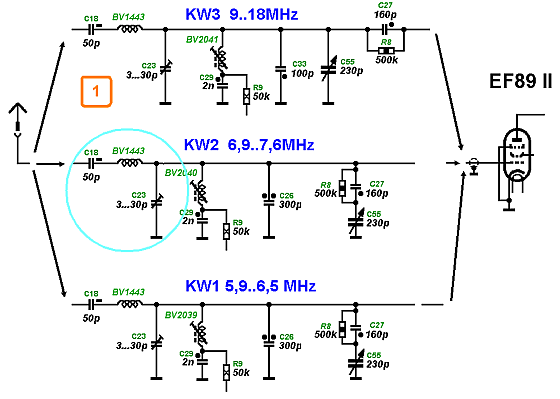
Wozu dient die Kombination C18/BV1443/C23 die ja für alle KW-Bereiche die gleiche ist und damit den Bereich 6-18 MHz abdecken muss?
Weiterhin viel Spass
Thomas
Hier geht es zu den bisherigen Beiträgen unserer Schaltungsanalyse:
Teil -1- -2- -3- -4-
Thomas Günzel † 1.8.22, 18.Apr.07
(Translation of text originally by Thomas Günzel)

Here are links to Part_1, Part_2, and Part_3 and a link to the complete_schematic_diagram.
The FM IF Amplifier (continued)
Dear friends of the forum,
To keep the threads from getting too long, we'll begin Part 4 here.
Here is another excerpt from the schematic diagram:
For an enlarged view, simply click on the diagram below!
Question 3:
On the control grid of the EBF80 there is an R-C circuit (R17/C85) similar to the one discussed previously (R24/C86) on the grid of the EF89 II.
Does this also play a role in gain regulation?
Question 4:
The suppressor grid of the EBF80 is not connected to ground; instead it is connected to the junction of C97, C98, and R41.
What is the purpose of this connection?
Enjoy!
Thomas G.
Thomas Albrecht, 22.Mar.07
Der komplette Schaltplan V1.3 hier
Liebe Freunde des Forums
Um die Threads nicht zu lange werden zu lassen, hier nun schon der 4.Teil.
Dazu wieder ein Schaltungsausschnitt:
Am Steuergitter der EBF80 befindet sich eine ähnliche RC-Kombination (R17/C58) wie die schon besprochene Kombination (R24/C86) am Gitter der EF89 II.
Wird hier nochmals nachgeregelt?
Frage 4:
Das Bremsgitter der EBF80 liegt nicht auf Masse, sondern führt zum Verbindungspunkt C96/97_R41.
Wozu dient diese Verbindung?
Weiterhin viel Spaß
Thomas
Thomas Günzel † 1.8.22, 21.Mar.07
(Translation of text originally by Thomas Günzel)

Here are links to Part_1 and Part_2.
The complete schematic diagram v1.3 is here.
The FM IF Amplifier
Dear friends of the forum,
Now that we have had a detailed 2-part discussion of the FM tuner, we'll move on to the IF amplifier.
See this diagram for my first question:
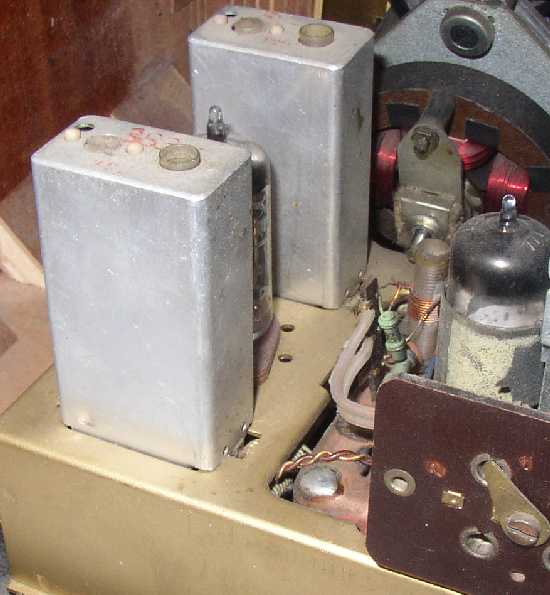
Circuitry:
Why was the connection from the FM tuner to the first IF stage made with a twisted pair?
On the primary winding of the first IF transformer there is no capacitor. Does that mean it has only one tuned circuit, and the primary coil is just an inductive coupling?
Production:
Before final assembly, the FM tuner had previously been aligned!
The routing of the twisted pair couldn't be done exactly the same every time. Was it necessary after assembly of the complete set to readjust the coil in the tuner (at the anode of the second section of the ECC85), or was it sufficient to simply adjust the first IF transformer?
I'm looking forward to lively participation. Whoever doesn't have access to post in this forum is welcome to send me (Thomas G. or Tom A.) questions by email.
Thomas G.
[To send an email to me (Tom A.), click on "mail to the author" at the bottom of this thread. To send an email to Thomas G., go the the German_thread and click on "mail to the author" at the bottom of the first post.]
Thomas Albrecht, 10.Mar.07
Der FM-ZF-Verstärker

Liebe Freunde des Forums,
Nachdem wir nun den UKW-Tuner in 2 Teilen ausführlich behandelt haben, geht's nun weiter mit dem ZF-Verstärker.
Hierzu nun meine erste Frage:
Warum wurde der Übergang vom UKW-Tuner zur ersten ZF-Stufe anhand einer verdrillten Leitung realisiert?
An der Primärwicklung des ersten Filters ist keine Kapazität. Ist es somit nur ein einkreisiges Filter mit induktiver Einkopplung?
Produktion:
Der UKW-Tuner war schon vorabgeglichen!.
Die Verlegung der verdrillten Leitung konnte aber nie exakt sein.
Mußte im fertigen Gerät nochmals an der Spule (Anode ECC85 II) im UKW-Tuner gedreht werden, oder genügte ein Abgleich am 1. ZF-Filter?
Ich freue mich auf eine rege Anteilnahme.
Wer keine Schreibrechte hat kann mir seine Fragen gerne per Email schicken
Thomas
Schaltung:
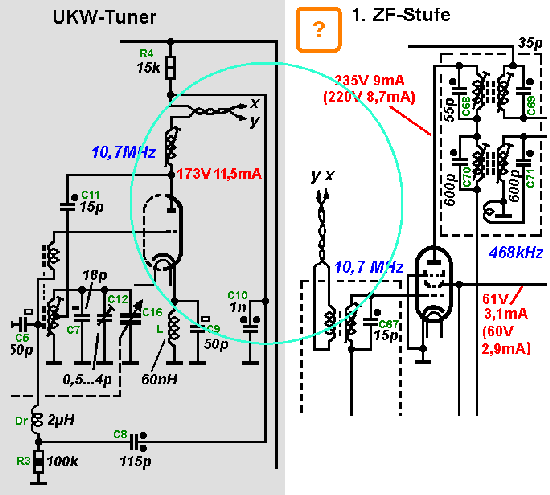
Thomas Günzel † 1.8.22, 10.Mar.07
I respectfully request some comments which may impact the final procedures during this cabinet restoration.
Replies may be in English or German - it is immaterial to my basic question:
Would there be any adverse effects if I replaced the original decorative "brass-colored" trim (only those pieces on the left and right sides which curve around the side speakers) with the proper solid brass alloy wiring?? The original material is NOT metal on this version. I can not attest to the other versions; nor does it appear that this trim has ever been removed or replaced.
Also, on the Majestic variant, the decorative trim does not connect to either AM or FM antenna systems. And during the refinishing, the stripping chemicals were observed to remove the "brass-colored" enamel or lacquer from what appears to be a hard plastic or vinyl strip (monofilament core). This material is nearly identical to the old "fender welting" strips applied to automobiles when body and fender panels were bolted on (MANY years ago), with the only difference being that this trim material is much smaller in diameter.
I have ordered the category 260 alloy brass wire in sizes 12 gauge (.081"), and 14 gauge (.064"). The actual width of the original trim material groove measures up to nearly .070".
The reason I ask is because I have not seen any forum discussions which relate to this specific topic; and I allude to some earlier comments regarding the interaction of the "wire trim" on some models . . .Reference post 29 to the original thread submitted by Herr Jochen Amend
I have taken many recent photographs of the cabinet and various small trim pieces; and will submit a few to reflect the "before and after" status.
It is my expectation to approach the outstanding quality of work achieved by Herr Martin Renz on his Siemens G7 dual-colored cabinet and others he has displayed. His outstanding in-depth discussion of techniques to apply new lacquer coatings to the various woods on our radio cabinets has also been of great benefit to all members.
The attached photo depicts the temporary insertion of 14 gauge solid copper decorative wire for the purpose of evaluation.
Respectfully,
Robert Sarbell
Anexos
- Metal decorative trim (108 KB)
Robert Sarbell † 22.3.22, 27.Feb.07
(Translation of text originally by Thomas Günzel)

Here is a link to Part_1 of this continuing series.
The FM oscillator and mixer
We are now continuing on with the oscillator and mixer stages.
Here are two questions:
1. What is the purpose of the R-C combination R3-C8 along with a choke of about 2 µH?
2. Why is there a resonant circuit (L and C9) between the cathode of the ECC85 and ground?

Part 1 of our circuitry analysis can be found here:
I hope you enjoy this ongoing project.
Thomas G.
Thomas Albrecht, 26.Feb.07
Der UKW-Oszillator und die Mischung
Hier geht's nun weiter mit dem Oszillator und der Mischstufe.
Dazu stelle ich zwei Fragen:
1. Welche Aufgabe hat die RC-Kombination C8-R3 zusammen mit einer Drossel von ca. 2µH?
2. Warum liegt in der Kathodenleitung der ECC85 ein Schwingkreis aus L und C9?

Den Teil 1 unserer Schaltungsanalyse finden Sie hier:
Schaltungsanalyse eines Röhren-Großsupers
Weiterhin viel Spaß an diesem wohl etwas länger dauerndem Projekt
Euer
Thomas
Thomas Günzel † 1.8.22, 17.Feb.07
1. Anyone may ask questions, and we encourage you to do so.
2. Answers should only be given by those who are certain of their answers; please avoid conjectures.
Thomas Albrecht, 09.Feb.07
Liebe Freunde des Radiomuseums,
Wir werden zunächst beim UKW-Tuner beginnen und uns über die ZF-Stufe inklusive "Magischem Auge" bis zum Eingang des NF-Teils vorarbeiten.
Anschließend werden wir den AM-Teil bis zum Lautsprecher anpacken.
Es lassen sich leicht Schaltungsauschnitte mit Hilfe von Grafikprogrammen ausschneiden um sie als Basis für Fragen und Antworten zu nehmen. Siehe erste Beispiele im nachfolgenden Post
Der Plan kann hier von Jedermann heruntergeladen werden und kostet keine UACS-Punkte:
Damit dieser Thread nicht im Chaos endet, sind zwei einfache Regeln einzuhalten:
1. Fragen stellen darf jeder und sind auch erwünscht.
2. Antworten dürfen nur jene, die sich Ihrer Aussage sicher sind und nicht nur Vermutungen äußern.
Wir wollen hier keine endlosen Diskussionen über "Wenn" und "Aber" oder "Vielleicht"!
Weiterhin sollte beachtet werden, daß Fragen nur zum laufenden Schaltungsblock gestellt werden!
Also keine Fragen zum Klangregler, solange wir noch den UKW-Tuner behandeln.
Als Einstieg und Grundlage möchte ich hier noch auf den hervorragenden Abschnitt "Kleine Schaltungslehre" aus Herrn Erb's Buch "Radios von Gestern" verweisen, der schon sehr viele Einblicke in die Schaltungstechnik von damals bietet.
Ich hoffe auf eine rege Anteilnahme und wünsche Euch viel Spaß und Freude an diesem Vorhaben.
Thomas Günzel
Thomas Günzel † 1.8.22, 09.Feb.07
I apologize for answering in English; however, in July 2005 I translated the complete Grundig TI 2/54 document - and I also received a great help from Hans Knoll - to fully understand the
Motor tuning structure, function, and service - even to include "Einstellung der Wanderscheiben-Rutschkupplung" . . . . .
The information is located on page 3, and includes the figures 8 through 11. Figure 8 depicts the technician checking the tension. The instructions state "Bremsmesswert von 320.....350gr.
The complete Grundig T/I document is available in RMorg.
Respectfully,
Robert
NOTE:
Robert Sarbell † 22.3.22, 12.Oct.06
Sehr geehrte Sammlerkollegen,
Andreas Hoppe, 11.Oct.06
Bei meinem Gerät fehlt jedoch der Ein/Ausschalter für den Motorbetrieb.
Das heißt man kann das Gerät nur manuell bedienen oder man stellt an dem Seilzug innen am Tastenblock auf ein, dann funktioniert der Motor, aber eine Einstellung per Hand ist dann nicht mehr möglich! Der Motor auf UKW läuft dann aber nur auf 2 voreingestellte Sender, die nicht verändert werden können! Kann so etwas sein?
Danke
Werner Riethmüller
Werner Riethmüller, 16.Mar.06
aus einer Sammlungsauflösung kaufte ich für 40 Euro dieses schöne Gerät, welches auch optisch noch ordentlich was hermacht.
Auf AM ergibt sich das gleiche Bild: die EM schlägt nur ein Drittel aus, hier ist meiner Meinung nach auch zuwenig "Druck auf der Leitung". Wie hoch ist denn die Spannung, die zu einem Vollausschlag der EM85 führt ?
H. P., 19.Jan.06
After some research into the UKW (FM) bandwidth, I am perplexed as to how difficult it might be to slightly "increase" the 100Mhz (or 104 Mhz) within the European radios to avoid the use of an add-on FM converter or FM expander.
While stationed in Japan from August 1965 until August 1968, in order to receive the Japanese FM stations on US made radios, there were small FM converters sold which covered the 76 - 90 Mhz range, and had circuitry to produce the IF 89Mhz (+/-500khz). The unit was powered by 6 UM-2 (1.5v D-size batteries) and used three transistors. Power consumption was 1VA.
I realize the above explanation relates to a decrease in the FM bandwidth - my question relates to a slight increase.
Would the additional modifications to the present circuits be sufficiently difficult to increase the FM reception range by 1 or 2 Mh??
Respectfully,
Robert
Robert Sarbell † 22.3.22, 25.Jun.05
http://www.radiomuseum.org/forum/additive_mischschaltungen_in_den_am_wellenbereichen.html
finden Sie ausführliche Informationen zum Thema Additive Mischung in den AM-Bereichen.
Andreas Steinmetz, 09.Jun.05
Unter: http://www.radiomuseum.org/dsp_forum_post.cfm?thread_id=25496
habe ich eine erweiterte Version , mit grosser Auflösung,eingestellt.
Hans M. Knoll
Hans M. Knoll, 21.May.04
I have recently bought the model 5040W3D from ebaY seller in the US. I have copied the 4 sheets of Technical Information you referred to in your forum post. Do you, or any other radiomuseum member know if the information was translated into English. I believe I have seen a reference for an export model as Grundig 5040W/3D "Ausfuhrung B" . . .
I am beginning the complete restoration of this impressive model, and would be most appreciative of any technical hints. I have performed some service (in 1976-1978) on the "signal sensing tuners" employed in the US automobile radios of the mid-1950s. . . .with the "Wonder Bar" tuning. Is the Grundig system quite similar with an unlatching and locking (stop) mode dependent upon signal strength?
Thank you so much
Respectfully,
Robert
I only changed the language flag (Ernest). You can delete my text by editing and your name will be there as editor.
Robert Sarbell † 22.3.22, 15.Jul.04
Anexos
- Einleitung (43 KB)
- Teil1 (209 KB)
- Teil2 (222 KB)
- Teil3 (226 KB)
- Teil4 (221 KB)
- Einleitung als pdf (32 KB)
Hans M. Knoll, 19.Jun.03
